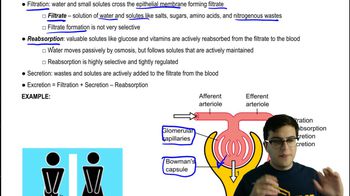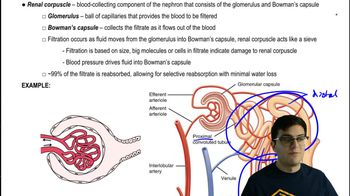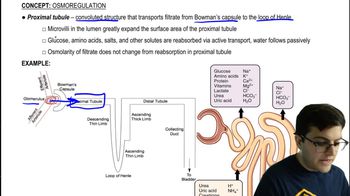Table of contents
- 1. Introduction to Biology2h 40m
- 2. Chemistry3h 40m
- 3. Water1h 26m
- 4. Biomolecules2h 23m
- 5. Cell Components2h 26m
- 6. The Membrane2h 31m
- 7. Energy and Metabolism2h 0m
- 8. Respiration2h 40m
- 9. Photosynthesis2h 49m
- 10. Cell Signaling59m
- 11. Cell Division2h 47m
- 12. Meiosis2h 0m
- 13. Mendelian Genetics4h 41m
- Introduction to Mendel's Experiments7m
- Genotype vs. Phenotype17m
- Punnett Squares13m
- Mendel's Experiments26m
- Mendel's Laws18m
- Monohybrid Crosses16m
- Test Crosses14m
- Dihybrid Crosses20m
- Punnett Square Probability26m
- Incomplete Dominance vs. Codominance20m
- Epistasis7m
- Non-Mendelian Genetics12m
- Pedigrees6m
- Autosomal Inheritance21m
- Sex-Linked Inheritance43m
- X-Inactivation9m
- 14. DNA Synthesis2h 27m
- 15. Gene Expression3h 20m
- 16. Regulation of Expression3h 31m
- Introduction to Regulation of Gene Expression13m
- Prokaryotic Gene Regulation via Operons27m
- The Lac Operon21m
- Glucose's Impact on Lac Operon25m
- The Trp Operon20m
- Review of the Lac Operon & Trp Operon11m
- Introduction to Eukaryotic Gene Regulation9m
- Eukaryotic Chromatin Modifications16m
- Eukaryotic Transcriptional Control22m
- Eukaryotic Post-Transcriptional Regulation28m
- Eukaryotic Post-Translational Regulation13m
- 17. Viruses37m
- 18. Biotechnology2h 58m
- 19. Genomics17m
- 20. Development1h 5m
- 21. Evolution3h 1m
- 22. Evolution of Populations3h 52m
- 23. Speciation1h 37m
- 24. History of Life on Earth2h 6m
- 25. Phylogeny2h 31m
- 26. Prokaryotes4h 59m
- 27. Protists1h 12m
- 28. Plants1h 22m
- 29. Fungi36m
- 30. Overview of Animals34m
- 31. Invertebrates1h 2m
- 32. Vertebrates50m
- 33. Plant Anatomy1h 3m
- 34. Vascular Plant Transport2m
- 35. Soil37m
- 36. Plant Reproduction47m
- 37. Plant Sensation and Response1h 9m
- 38. Animal Form and Function1h 19m
- 39. Digestive System10m
- 40. Circulatory System1h 57m
- 41. Immune System1h 12m
- 42. Osmoregulation and Excretion50m
- 43. Endocrine System4m
- 44. Animal Reproduction2m
- 45. Nervous System55m
- 46. Sensory Systems46m
- 47. Muscle Systems23m
- 48. Ecology3h 11m
- Introduction to Ecology20m
- Biogeography14m
- Earth's Climate Patterns50m
- Introduction to Terrestrial Biomes10m
- Terrestrial Biomes: Near Equator13m
- Terrestrial Biomes: Temperate Regions10m
- Terrestrial Biomes: Northern Regions15m
- Introduction to Aquatic Biomes27m
- Freshwater Aquatic Biomes14m
- Marine Aquatic Biomes13m
- 49. Animal Behavior28m
- 50. Population Ecology3h 41m
- Introduction to Population Ecology28m
- Population Sampling Methods23m
- Life History12m
- Population Demography17m
- Factors Limiting Population Growth14m
- Introduction to Population Growth Models22m
- Linear Population Growth6m
- Exponential Population Growth29m
- Logistic Population Growth32m
- r/K Selection10m
- The Human Population22m
- 51. Community Ecology2h 46m
- Introduction to Community Ecology2m
- Introduction to Community Interactions9m
- Community Interactions: Competition (-/-)38m
- Community Interactions: Exploitation (+/-)23m
- Community Interactions: Mutualism (+/+) & Commensalism (+/0)9m
- Community Structure35m
- Community Dynamics26m
- Geographic Impact on Communities21m
- 52. Ecosystems2h 36m
- 53. Conservation Biology24m
42. Osmoregulation and Excretion
Osmoregulation and Excretion
Problem 18
Textbook Question
Textbook QuestionTwo endothermic animals are the same size, but one is a carnivore and the other is an herbivore. Predict which of these animals would produce the greatest amount of nitrogenous wastes. Explain.
 Verified step by step guidance
Verified step by step guidance1
Understand the metabolic processes of carnivores and herbivores. Carnivores primarily consume meat, which contains high levels of protein. Herbivores consume plant-based diets, which are generally lower in protein.
Recognize that protein metabolism in animals leads to the production of nitrogenous wastes such as urea or uric acid.
Consider the dietary intake of the two animals. Since the carnivore consumes a higher protein diet, it metabolizes more protein compared to the herbivore.
Relate the amount of protein metabolized to the production of nitrogenous wastes. More protein metabolism results in more nitrogenous waste production.
Conclude that the carnivore, which consumes a diet richer in proteins, would produce a greater amount of nitrogenous wastes compared to the herbivore.
Recommended similar problem, with video answer:
 Verified Solution
Verified SolutionThis video solution was recommended by our tutors as helpful for the problem above
Video duration:
1mPlay a video:
Was this helpful?
Key Concepts
Here are the essential concepts you must grasp in order to answer the question correctly.
Endothermy
Endothermy refers to the ability of an organism to regulate its body temperature internally, allowing it to maintain a stable temperature regardless of external conditions. This metabolic process requires a significant amount of energy, which is derived from the food the animal consumes. Endothermic animals, such as mammals and birds, typically have higher metabolic rates compared to ectothermic animals, influencing their energy and waste production.
Recommended video:
Guided course

Thermoregulation
Nitrogenous Wastes
Nitrogenous wastes are byproducts of protein metabolism, primarily consisting of urea, uric acid, and ammonia. These wastes are produced when proteins and nucleic acids are broken down for energy or other metabolic processes. The amount and type of nitrogenous waste produced can vary significantly between carnivores and herbivores, with carnivores generally producing more due to their higher protein intake from animal tissues.
Recommended video:
Guided course

Osmoregulation and Nitrogenous Waste
Dietary Influence on Metabolism
The diet of an animal significantly influences its metabolic processes and waste production. Carnivores typically consume high-protein diets, leading to increased protein catabolism and, consequently, higher nitrogenous waste output. In contrast, herbivores consume plant material, which is generally lower in protein and may result in lower nitrogenous waste production. This dietary difference is crucial for predicting the amount of nitrogenous waste produced by the two animals in the question.
Recommended video:
Guided course

Metabolic Rate

 7:16m
7:16mWatch next
Master Osmoregulation and Nitrogenous Waste with a bite sized video explanation from Jason Amores Sumpter
Start learningRelated Videos
Related Practice


































































